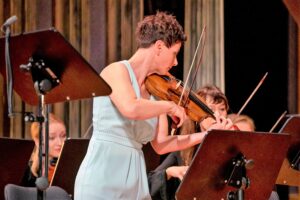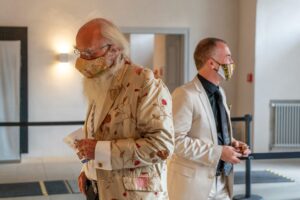This was meant to be a beautiful marriage. Elisabeth Friederike Sophie, daughter of Frederick, Margrave of Bayreuth, and Princess Wilhelmine of Prussia, Frederick the Great’s elder sister, dazzled no less a figure than Casanova, who pronounced her one of the most beautiful eligible ladies in Germany. Her charms were appreciated also by Charles Eugene, Duke of Württemberg – the twelve-year-old girl caught his eye in 1744, during his visit to the Bayreuth court. Other suitors, including the King of Denmark, had been queuing for the hand of the margrave’s daughter, but Elisabeth’s parents chose Charles, a protégé of his uncle Frederick. The young couple’s wedding, on 26 September 1748, came to be known as the most sumptuous celebration in the history of the Margraviate of Brandenburg-Kulmbach. The gifts the newlyweds received included a brand-new opera house – modelled on Italian box theatres, designed and made with great care by leading artists and craftsmen of the day.
The main person behind this unusual gift was Margravine Wilhelmine: a woman of many talents, including a talent for music. She learned to play the lute with none other than Silvius Leopold Weiss and later became a patron of the work of Bernhard Joachim Hagen, the last of the great German lutenists. In addition, she was also quite a talented composer. Some of her pieces have survived to this day and continue to generate keen interest among musicians. They include Clarinet Concerto in G minor – in which the obbligato flute part was sung with great pleasure by her husband or brother Frederick, pupils of the great flautist Johann Joachim Quantz – and the opera Argenore, written in 1740 for her husband’s birthday. The margravine may, in fact, have built the Bayreuth theatre, not so much thinking about her beloved only daughter and her husband, a great lover of arts, but intending to stage her own works there. After all, she had brought together a troupe of the finest instrumentalists and singers long before her daughter’s wedding, already in 1737.
Gismondo at the Margravial Opera House. Photo: Andreas Harbach
Wilhelmine knew what she wanted. She entrusted the design of the opera house interior to Giuseppe Galli-Bibiena, the most outstanding representative of an Italian family of painters and theatre architects, and a court artist to the Saxons in Dresden. His son Carlo remained at the Bayreuth court until the margravine’s death, designing sets for successive performances at the opera house – using extraordinary wooden structures lit from the inside, which took the audience’s breath away with the power of stage illusion. The construction of the Rococo facade of grey sandstone – after a design by the margraves’ court architect Joseph Saint-Pierre – was completed two years after the opening of the building. Performances were regularly given for ten years. Wilhelmine would provide the musicians with fresh scores, arrange the artists on stage and often herself appear in stagings of her operas and Singspiele.
The margravine’s beautiful dream ended with her death in 1758. Her daughter’s beautiful marriage had turned out to be a disaster even before that. Shortly before Wilhelmine’s death Elisabeth – cheated on and kept away from state matters by her husband – had given birth to her only child: a daughter whom Charles did not want and did not love, and who survived for only a year. Complete silence fell over the Margravial Opera House. Ironically, this may have been the reason why the theatre survived centuries almost intact – with the exception of the theft of the curtain, stolen by Napoleon’s soldiers who marched through Bayreuth in 1812 on their way to Russia. Sixty years later the vast, nearly thirty metres deep Baroque stage inspired Richard Wagner, who was working on a design for his own Festspielhaus with the famous double proscenium and the “mystical abyss” of the covered orchestra pit.
I saw the interior of the Opernstrasse theatre, a true jewel in the Hohenzollerns’ crown, for the first time last year – soon after the completion of a thorough renovation of the building, which took nearly six years and cost nearly thirty million euros. No wonder: elements of the decorations were restored centimetre by centimetre, with great care for every detail of the exquisite woodwork, for every flash of light in the gilding, for the deceptive perspective of the illusionistic paintings. At the Margravial Opera House everything is theatre: even when the auditorium is empty and there is no one on stage. The magic of the place began to attract artists already towards the end of the previous century. In the mid-1990s several memorable scenes from Gérard Corbiau’s film Farinelli about the famous Italian castrato were shot here. At more or less the same time the Markgräfliches Opernhaus became the venue of the Easter Festival – with a programme ranging from Bach to Mahler, organised with the Internationale Junge Orchesterakademie and seeking primarily to promote young ambitious musicians.
Martyna Pastuszka. Photo: Andreas Harbach
Yet something continued to be missing: music and drama created during the time of Princess Wilhemine of Prussia, i.e. Baroque opera with all the arsenal of its magic and illusion, which in no other theatre can impress the spectators as much as they do in the setting conjured up by the great Bibienas. In January there came the news awaited not only by music lovers but also “ordinary” residents of Bayreuth – a small town which every year sank into an autumn stupor after the end of the Wagner Festival. Bayreuth Baroque, a new festival was announced to be held in the first half of September under the artistic direction of the Croatian countertenor Max Emanuel Cenčić. The programme – in addition to concerts and recitals by period performance stars – featured a full staging of Nicola Antonio Popora’s Carlo il Calvo directed by Cenčić, who also sang Lottario; and a concert performance of Leonardo Vinci’s dramma per musica, Gismondo, Rè di Polonia, featuring soloists and {oh!} Orkiestra Historyczna conducted by Martyna Pastuszka.
Such a turn of events was not expected even by the biggest fans of the young orchestra from Silesia. Eight years had passed since their first concert, years spent not only painstakingly editing source material and artistically developing the ensemble as a whole as well as each musician separately, but making efforts to bring about a breakthrough in the organisation and financing model of niche cultural projects. Nevertheless, Pastuszka’s orchestra was lucky. In 2015 it managed to establish regular collaboration with the Polish National Radio Symphony Orchestra, one of the most thriving musical institutions in Poland. Three years later it made its debut at the Chopin and His Europe festival in Warsaw: from that moment, thanks to the Fryderyk Chopin Institute, it has been systematically adding Romantic pieces to its repertoire. It had several encounters that turned out to be providential; among them was the encounter with Łukasz Strusiński, an expert from the Adam Mickiewicz Institute, who from the very beginning accompanied the musicians in their most ambitious project to date – attempt to bring back from obscurity a forgotten opera by Vinci, one of the leading representatives of the Neapolitan school, a rival of Porpora and teacher of Pergolesi. The attempt has been more than successful, as is evidenced by the triumphant march of Gismondo through European concert halls, but also by the award-winning recording for Parnassus Arts, warmly received by the critics. Of course, another man behind all these successes is also Cenčić – the first modern interpreter of the role of Sigismund Augustus and co-producer of the whole project, supported by a veritable army of organisers and sponsors, headed by the Mickiewicz Institute and the Orlen Deutschland GmbH company.
Times are changing. The role of the Florentine Medicis and the Venetian Doges’ Council is now played by commercial companies, which are not always easy to persuade to pump money into a niche orchestra’s venture focused on a little known composer. This makes it even more special that all these benefactors did not back off, when the spectre of the pandemic loomed not only over Gismondo, but also over the entire festival. The epidemic situation in Bavaria had been far from optimistic for months. When the Bayreuther Festspiele and with it a much-publicised new staging of Der Ring des Nibelungen fell victim to the virus, the musical world held its breath. But the determined founders of Bayreuth Baroque closed ranks even more. They made a desperate attempt to organise the event in accordance with the existing sanitary regime and without any cuts to the programme. Decisions hung in the balance almost until the very last moment – including the decision to make all the festival events available online as. Miraculously, it worked. Those who sneered at the “full” house with empty seats in the auditorium, must have looked far from happy to hear that the first Baroque opera celebration at the Markgräfliches Opernhaus attracted as many as 360,000 viewers watching it online.
I had more luck than they did. Not only was I able to hear Gismondo live, but I was also seated on the balcony, right next to the lavish ducal box. The legend has it that the margrave and his wife rarely used it, preferring instead to relish the magic of theatre from the first row of the stalls, right next to the proscenium – yet the mastery of the Bibienas’ architecture is best admired from above, looking into the seemingly infinite depth of the Baroque stage. Sound is reflected from the wooden elements of the interior softly and cleanly, and easily reaches every nook and cranny of the auditorium.
In the foyer. Photo: Andreas Harbach
And this was enough to appreciate even a concert performance of Gismondo, with the {oh!} Orkiestra charming the audience with its trademark rounded sound and excellent understanding among the musicians. The complicated story of honour and love (with the Polish-Lithuanian union in the background), far removed – as is often the case with Neapolitan opera – not just from historical truth but also from any plausibility, unfolded smoothly and lively, also thanks to the soloists, most of whom were already familiar with Vinci’s score. Most, because there were some surprises – the Bashkir soprano Dilyara Idrisova failed to arrive for logistical reasons and was replaced in the role of Judith by Hasnaa Bennani, an otherwise fine singer. But the singer who shone like a jewel in the rest of the female cast was Sophie Junker, a velvety-voiced Cunegonde with an excellent sense of drama and musical prosody. I’m not a fan of Cenčić’s countertenor, but I have to admit that he skilfully created a character of the wise and good-natured King Sigismund. Yuriy Mynenko as Ottone made up for some slight technical shortcomings with the extraordinary beauty of his lyrical male soprano.
Vinci’s opera – fresh, full of unconventional solutions and performed with verve and grace – took the listeners by storm. Given a standing ovation, the musicians thanked the audience with an encore featuring a fragment of the finale. The next concert, presented two days later, is said to have generated even more enthusiasm – a point worthy of note, as the guests from Poland had already returned home. Some German critics hailed Gismondo as the biggest revelation of the festival.
I wished I had seen the entire Bayreuth Baroque. I would love to share the optimism of the organisers, who are already making plans for the next season, trusting that nature itself will overcome the epidemic and if not – that we will vanquish the virus with a vaccine. May their hopes not be in vain. The marriage between the Margravial Opera House and Baroque music is certainly beautiful. May it also be happy every after.
Translated by: Anna Kijak
Original article available at: https://www.tygodnikpowszechny.pl/podroz-w-kraine-uludy-165140



